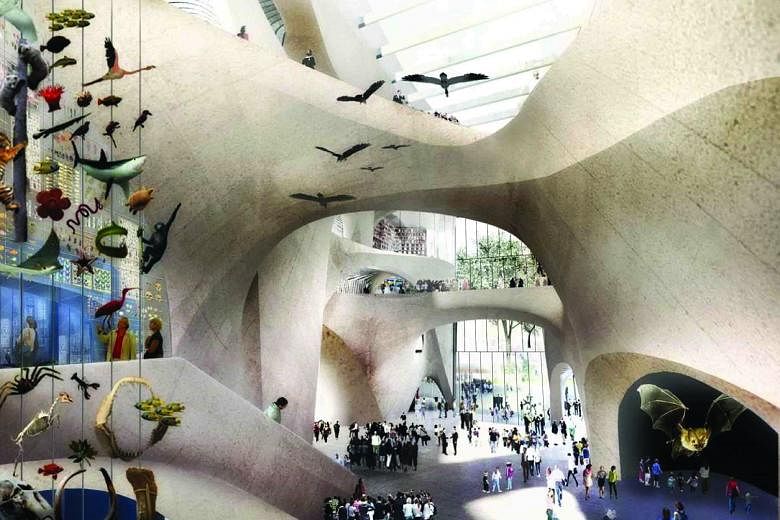NEW YORK • In designing its US$325-million (S$456.4-million) addition on Columbus Avenue, the American Museum of Natural History has opted for an architectural concept that is both cautious and audacious, according to plans approved by its board on Wednesday.
The design takes up less coveted park space than expected while introducing a contemporary aesthetic that evokes Frank Gehry's museum in Bilbao, Spain, in its undulating exterior and Turkey's underground city of Cappadocia in its cave-like interior.
The design, by American architect Jeanne Gang for the new Richard Gilder Center for Science, Education and Innovation, aims to unite the museum's various activities, solve its notorious circulation problems and provide a multi-storey showcase for the institution's expanding role as a hub for scientific research and scholarship.
Ms Gang said she was looking to conjure spaces that have been created by forces of nature, such as geological canyons, and to foster a sense of connectivity and discovery.
The museum has yet to present the design to neighbourhood groups and it will be subject to a public approval process.
Residents have objected to the idea of impinging on Theodore Roosevelt Park, which is on the back stretch of the museum grounds near West 79th Street in Manhattan, but is owned by the city.
In a response to this concern, the museum has decided to take down three of its existing buildings to make room for the six-storey addition, rather than to protrude deeper into the tree-lined space as had been anticipated.
"These are secondary buildings," said Ms Ellen Futter, the museum's president. "It allowed us to set the building back to encroach less - at no insignificant cost."
She said this cost would not increase the overall budget - savings would be found elsewhere.
Ms Gang's design calls for 218,000 sq ft of new space. The building will take up 11,600 sq ft of parkland. The rest is to be carved out of the museum's current structure.
The plan for the centre - to open in late 2019 or early 2020 - features a curvilinear stone and glass exterior that is intended to echo the museum's cylindrical towers and turrets.
The contemporary design seems to be a radical departure from the institution's dominant brick aesthetic, but it is meant to send a message that this is a new building for a new era. "We want to make the science visible," Ms Futter said.
"Science is a contemporary field."
The interior, which evokes the Flintstones' town Bedrock, is to be made of reinforced concrete that acts as structural support.
A new entrance area on Columbus Avenue, centred between 79th and 80th streets, will be a hub for all things science in the museum, offering a multi-storey enclosure with cabinets, drawers and shelves for storing specimens and objects; a series of open, recessed chambers that highlight the exhibitions; an "interpretive wall" to orientate visitors and help with wayfinding; an insect hall that will be home to the museum's live butterfly conservatory; and clear directions to the library, laboratories and classrooms.
The space will also include a new Invisible Worlds Theater, with the latest imaging technology focused on revealing the inside of the brain or a grain of sand.
The new building creates the cross axis originally envisioned by the museum's 19th-century masterplan, which was never realised. Over the years, the institution has become a hotchpotch of 25 structures that are often difficult to navigate.
"It's a labyrinth in there," said Mr William Higgins, a specialist in landmarks issues who is a consultant to the museum.
Ms Futter said the new building represents her institution's response to "a crisis in science education in this country".
She said that the United States had fallen behind in "overall preparedness and global competitiveness" and that it was the museum's duty to ready New York City schoolchildren for science jobs of the future in areas such as forensics and healthcare.
More immediately, the museum is bursting at the seams with a collection of specimens that grows by as many as 100,000 objects a year and annual attendance that increased by nearly 70 per cent over the past 20 years, to 5 million from 3 million.
NEW YORK TIMES

